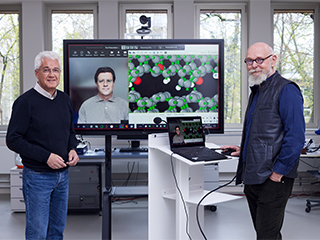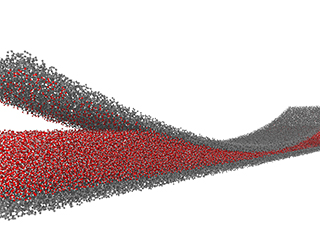Mechanical components
Virtually frictionless — virtual material probe sheds light on the friction gap
Ensuring that power plants operate without breaking down and that vehicles run energy-efficiently ultimately depends on just a few atoms. A virtual material probe makes it possible to see, and therefore control, tribological processes at the atomic level. A team of researchers from the Fraunhofer Institute for Mechanics of Materials IWM is being awarded the Stifterverband Science Prize 2022 for this development.

Friction and wear are all-pervasive in mechanical components. Because of this, mechanical seals for pumps or compressors make use of diamond coatings: The crystalline material protects components that rub against each other, allowing them to slide smoothly over one another, and therefore ensures a long service life. However, sharp fluctuations in the coefficient of friction, and in rare cases even total system failures, can cause damage costing millions of euros. The causes of these high coefficients of friction and the conditions needed to keep friction at a constant low level were not previously known.
Now, a team of researchers has solved the diamond friction mystery using a virtual material probe. This combines simulations at multiple scales with real experiments and can effectively see into the gap between components as they come into contact — the only one of its kind. Prof. Michael Moseler and Prof. Matthias Scherge of Fraunhofer IWM are receiving the Stifterverband Science Prize 2022 for developing this probe. The third member of the team, Dr. Joachim Otschik of EagleBurgmann Germany GmbH & Co., will also be receiving the award. The jury was particularly impressed by the trio’s years of research cooperation, support for the development of the probe and contribution to our understanding of the phenomenon of friction in mechanical seals.
The virtual material probe illuminates a mystery
The virtual material probe helps in any situation where two bodies rub against one another and are lubricated with an atom-thin liquid film — whether in components for a future hydrogen economy, electric vehicle drive trains or heat pump compressors. “We will never understand the effects of friction or the effect of the wafer-thin lubricant film through experiments alone — tribological contact is essentially a mystery,” explains Scherge.
Moseler, his colleague, adds: “With the virtual material probe, on the other hand, we can zoom from the millimeter to the atomic scale, and in extreme cases even to the quantum mechanical level of the electrons, to understand binding properties in the gap between components.” This is no small matter: Ultimately, even a relatively small number of the right or wrong atoms on the surface of a component can make the difference between a seal working perfectly and total failure due to friction and wear.
However, developing the virtual material probe was only possible through cooperation with industry: EagleBurgmann has been involved in the project for over 15 years. “The synergy between us and Fraunhofer IWM is unique; it continues to grow and gain more and more momentum,” says Otschik. “The broad, in-depth understanding among our colleagues is absolutely world-class. With the virtual material probe, we have been able to shorten development times by at least 99 percent and secure a contract worth millions,” Otschik continues. That is not enough for EagleBurgmann, however: There are also plans to use the new tool to help develop water-lubricated diamond-coated mechanical seals that are entirely impermeable and virtually wear free and can operate with ultra-low friction. In short, the virtual material probe will bring lasting change to the world of friction processes.
Stifterverband Science Prize
For over 15 years, the Stifterverband has been awarding the prize (worth 50,000 euros) every two years together with the Fraunhofer-Gesellschaft. The prize rewards research projects in applied research that demonstrate scientific excellence, where Fraunhofer institutes work together with industry and/or other research organizations.
Watch the video of the prize winners here
Contact
Prof. Dr. Matthias Scherge
Phone +49 721 204327-12
Send email
Prof. Dr. Michael Moseler
Phone +49 761 5142-332
Send email
 Fraunhofer Institute for Mechanics of Materials IWM
Fraunhofer Institute for Mechanics of Materials IWM